| Listing 1 - 10 of 26 | << page >> |
Sort by
|
Book
ISBN: 1000006715 386644141X Year: 2007 Publisher: KIT Scientific Publishing
Abstract | Keywords | Export | Availability | Bookmark
 Loading...
Loading...Choose an application
- Reference Manager
- EndNote
- RefWorks (Direct export to RefWorks)
Ausgangspunkt des Buches war die Frage, inwiefern Unternehmen Open Source Software in ihren Produkten verwenden können, ohne hierdurch Lizenzverletzungen zu verursachen.Der Untersuchungsschwerpunkt lag dabei auf dem Einsatz von Open Source Software, die unter der General Public License lizenziert (GPL) ist und umfasste somit sämtliche Fragen des unternehmensinternen (Open Source)-Lizenzmanagements.
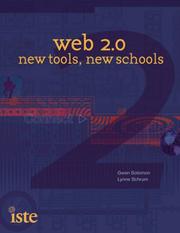
ISBN: 9781564842343 1564842347 Year: 2007 Publisher: Eugene, Or.: International Society for Technology in Education,
Abstract | Keywords | Export | Availability | Bookmark
 Loading...
Loading...Choose an application
- Reference Manager
- EndNote
- RefWorks (Direct export to RefWorks)
Educational technology --- Web sites --- Open source software
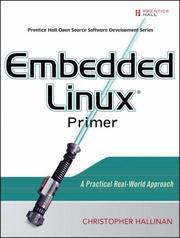
ISBN: 9780131679849 Year: 2007 Publisher: Upper Saddle River Prentice Hall
Abstract | Keywords | Export | Availability | Bookmark
 Loading...
Loading...Choose an application
- Reference Manager
- EndNote
- RefWorks (Direct export to RefWorks)
Programming --- Computer architecture. Operating systems --- embedded systems --- Open Source --- Linux
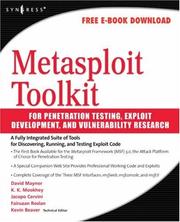
ISBN: 9780080549255 008054925X 9781597490740 1597490741 1281112585 9781281112583 9786611112585 6611112588 Year: 2007 Publisher: Burlington, MA Syngress
Abstract | Keywords | Export | Availability | Bookmark
 Loading...
Loading...Choose an application
- Reference Manager
- EndNote
- RefWorks (Direct export to RefWorks)
This is the first book available for the Metasploit Framework (MSF), which is the attack platform of choice for one of the fastest growing careers in IT security: Penetration Testing. The book and companion Web site will provide professional penetration testers and security researchers with a fully integrated suite of tools for discovering, running, and testing exploit code.This book discusses how to use the Metasploit Framework (MSF) as an exploitation platform. The book begins with a detailed discussion of the three MSF interfaces: msfweb, msfconsole, and msfcli .This chapter demonst
Computer. Automation --- Computer security. --- Open source software. --- Metasploit (Electronic resource)

ISBN: 9780415955430 0415955432 9780203937853 9781135916398 9781135916343 9781135916381 9780415541374 Year: 2007 Volume: 9. Publisher: London : Routledge,
Abstract | Keywords | Export | Availability | Bookmark
 Loading...
Loading...Choose an application
- Reference Manager
- EndNote
- RefWorks (Direct export to RefWorks)
The Free and Open Source Software (FOSS) movement demonstrates how labour can self-organise production, and, as is shown by the free operating system GNU/Linux, even compete with some of the worlds largest firms. The book examines the hopes of such thinkers as Friedrich Schiller, Karl Marx, Herbert Marcuse and Antonio Negri, in the light of the recent achievements of the hacker movement. This book is the first to examine a different kind of political activism that consists in the development of technology from below.
Open source software. --- Computer software --- Logiciels libres --- Logiciels --- Development --- Développement
Book
ISBN: 9781430204244 Year: 2007 Publisher: Berkeley CA Apress
Abstract | Keywords | Export | Availability | Bookmark
 Loading...
Loading...Choose an application
- Reference Manager
- EndNote
- RefWorks (Direct export to RefWorks)
Flex is the quickest and most effective technology for the creation of Rich Internet Applications for the Web. Its extensive library of components and totally customizable framework, combined with the ubiquity of Flash Player, has guaranteed its success. The ecosystem of products that rotate around Flex 2 and Flex 3 is really broad. Flex Builder, Flex SDK, and Charting Components are all essential parts of the technology that fit the different requirements of web development. This enormous set of possibilities can easily lead to information overload for developers like you. There's just too much to learn and too many potential places to go when you hit a brick wall. Wouldn't it be nice to have a library of solutions to solve these problems quickly and easily? This book provides just that, with more than 100 solutions to common problems in one handy volume. Flex Solutions: Essential Techniques for Flex 2 and Flex 3 Developers faces problems and provides solutions that can be applied to any project, from the most simple to the most complex. The solutions range from customizing Flex components with ActionScript 3.0, using the data models and the ActionScript classes as Value objects, validating and formatting data, using RPC classes to access remote data, to optimizing data-exchange performance using AMF3. Solutions are also provided for enhancing the security of Flex applications, and techniques are offered for optimizing the actual work environment by increasing the performance of Flex Builder, adding video content, and creating an AIR project to bring your web application onto the desktop. If you want to learn about and start to develop rich Internet applications in a short time, being immediately productive and mastering the Flex development techniques, Flex Solutions: Essential Techniques for Flex 2 and 3 Developers is the book you need. Discover real-world solutions for everyday Flex development, saving hours of development time Learn how to customize and extend the Flex Components Model and design and program the look and feel of your Flex applications Learn best practices and tips from a Flex expert for structuring the architecture of Flex applications Use the Flex Remote Procedure Classes to connect to remote data with HTTPServices and the Java Platform, PHP, ColdFusion, WebServices, and RemoteObject Use Flex 3 features such as the AdvancedDataGrid component and the Charting Enhancements feature Port your rich Internet applications onto the desktop with Adobe AIR
Programming --- websites --- Open Source --- ActionScript (informatica) --- webdesign --- programmeren (informatica) --- webapplicaties (informatica)
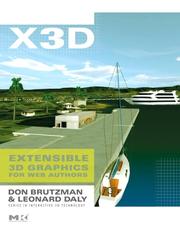
ISBN: 9780120885008 9780080489889 012088500X 0080489885 9786611053215 6611053212 Year: 2007 Publisher: Amsterdam Elsevier
Abstract | Keywords | Export | Availability | Bookmark
 Loading...
Loading...Choose an application
- Reference Manager
- EndNote
- RefWorks (Direct export to RefWorks)
In the early days of the Web a need was recognized for a language to display 3D objects through a browser. An HTML-like language, VRML, was proposed in 1994 and became the standard for describing interactive 3D objects and worlds on the Web. 3D Web courses were started, several best-selling books were published, and VRML continues to be used today. However VRML, because it was based on HTML, is a stodgy language that is not easy to incorporate with other applications and has been difficult to add features to. Meanwhile, applications for interactive 3D graphics have been exploding in areas such as medicine, science, industry, and entertainment. There is a strong need for a set of modern Web-based technologies, applied within a standard extensible framework, to enable a new generation of modeling & simulation applications to emerge, develop, and interoperate. X3D is the next generation open standard for 3D on the web. It is the result of several years of development by the Web 3D Consortium's X3D Task Group. Instead of a large monolithic specification (like VRML), which requires full adoption for compliance, X3D is a component-based architecture that can support applications ranging from a simple non-interactive animation to the latest streaming or rendering applications. X3D replaces VRML, but also provides compatibility with existing VRML content and browsers. Don Brutzman organized the first symposium on VRML and is playing a similar role with X3D; he is a founding member of the consortium. Len Daly is a professional member of the consortium and both Len and Don have been involved with the development of the standard from the start. * The first book on the new way to present interactive 3D content over the Web, written by two of the designers of the standard * Plentiful illustrations and screen shots in the full color text * Companion website with extensive content, including the X3D specification, sample code and applications, content creation tools, and demos of compatible Web browsers.
Computer architecture. Operating systems --- 3D computertoepassingen --- 3D (derde dimensie) --- websites --- Open Source --- webdesign
Book
Year: 2007
Abstract | Keywords | Export | Availability | Bookmark
 Loading...
Loading...Choose an application
- Reference Manager
- EndNote
- RefWorks (Direct export to RefWorks)
Open source intelligence --- Intelligence service --- Interagency coordination --- National security --- Evaluation. --- Methodology. --- Political science
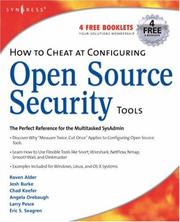
ISBN: 1281060275 9786611060275 0080553567 1597491705 9780080553566 9781597491709 Year: 2007 Publisher: Rockland, Mass. Syngress
Abstract | Keywords | Export | Availability | Bookmark
 Loading...
Loading...Choose an application
- Reference Manager
- EndNote
- RefWorks (Direct export to RefWorks)
The Perfect Reference for the Multitasked SysAdminThis is the perfect guide if network security tools is not your specialty. It is the perfect introduction to managing an infrastructure with freely available, and powerful, Open Source tools. Learn how to test and audit your systems using products like Snort and Wireshark and some of the add-ons available for both. In addition, learn handy techniques for network troubleshooting and protecting the perimeter.* Take InventorySee how taking an inventory of the devices on your network must be repeated regularly to ensure that
Computer networks --- Open source software. --- Security measures. --- Free software (Open source software) --- Open code software --- Opensource software --- Computer network security --- Network security, Computer --- Security of computer networks --- Computer software --- Computer security
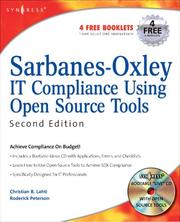
ISBN: 1281145165 9786611145163 0080557279 1597492167 9781597492164 Year: 2007 Publisher: Burlington, MA Syngress
Abstract | Keywords | Export | Availability | Bookmark
 Loading...
Loading...Choose an application
- Reference Manager
- EndNote
- RefWorks (Direct export to RefWorks)
The Sarbanes-Oxley Act (officially titled the Public Company Accounting Reform and Investor Protection Act of 2002), signed into law on 30 July 2002 by President Bush, is considered the most significant change to federal securities laws in the United States since the New Deal. It came in the wake of a series of corporate financial scandals, including those affecting Enron, Arthur Andersen, and WorldCom. The law is named after Senator Paul Sarbanes and Representative Michael G. Oxley. It was approved by the House by a vote of 423-3 and by the Senate 99-0. This book illustrates the many
Auditing, Internal - Data processing. --- Auditing, Internal. --- Information technology. --- Information technology - Management. --- Open source software. --- United States. --- Auditing, Internal --- Information technology --- Open source software --- Commerce --- Business & Economics --- Accounting --- Data processing --- Management --- Data processing. --- Management. --- Free software (Open source software) --- Open code software --- Opensource software --- Auditing --- Internal auditing --- Internal control --- Computer software --- Information Technology --- General and Others
| Listing 1 - 10 of 26 | << page >> |
Sort by
|

 Search
Search Feedback
Feedback About UniCat
About UniCat  Help
Help News
News